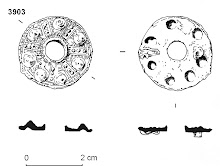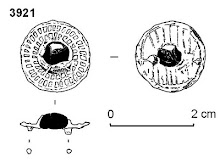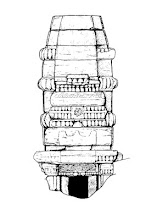Recent work has included a research project recording
medieval cross-slabs in local Gloucestershire churches. Cross-slabs are a
relatively overlooked class of medieval funerary monument compared to the better
known and often more magnificent effigy slabs and tombs. Cross-slabs are essentially
characterised by a central cross motif, although there is considerable variety
in their style and decoration, and there is overlap with other types of
monument.
Cross-slabs are usually formed from rectangular or tapered slabs of
stone with the principal cross decoration on the top face -which may be flat or
coped. The cross motif may be relatively simple, or be a complex ‘bracelet’
cross with fleur-de-lys terminals,
the cross is often shown surmounting a shaft, sometimes with a stepped Calvary.
In addition to the cross design there are sometimes further motifs such as
shears, chalices, keys and swords which may relate to the buried individual’s
occupation or status. The design can be incised or in bas relief or with an inlay of another colour. As a rule there are
not names or inscriptions on the slabs, but there are exceptions!
 |
| Cross-slab outside St Mary Edgeworth |
The decoration and style of cross design varies and changes
over time, and can be dated by reference to wider changes in architectural style,
as well as from the location –e.g. a slab reset in the base of a 14th
century arcade must be earlier. Some designs appear to be copies of earlier
designs, often crudely carved by masons possibly centuries later. As the number
of recorded slabs increases we will be able to refine the dating of the slabs,
as well as better understand the evolution and geographical spread of different
styles and designs.
The slabs were usually placed flat (recumbent) and may have
been placed over the specific burial both inside and outside the church. There is often a chamfered border
or roll moulding around the slab which indicates they were not set flush to the floor of the church or the churchyard surface but
slightly raised up. Half-size slabs also existed, although some may have been head
or foot-stones.
 |
| Medieval cross-slab or foot-stone, St Mary Edgeworth; the design may be based on a similar design on a cross-slab at St Kenelm Sapperton. Scale 10cm. |
Relatively few if any cross-slabs will be in their original
position - frequently they have been moved at least once. When churches were
enlarged or modified cross-slabs were often disturbed; sometimes they were
reused –either face up or face-down- in the new build, and were a convenient
size and shape for reuse as lintels and sills. Cross slabs were also often
disturbed by Victorian renovation works, and may be reset within the church in
order to display the decoration often they are set in the floor, the porch, or
set up against the church walls. Other cross-slabs have been found during
excavations within churches. Cross-slabs are vulnerable to damage –if reset in
floors they can be slowly worn away, if set up outside then they may be eroded by
the elements and lichen, if they are loose then they are at risk of being
damaged, or discarded.
 |
| Medieval cross-slabs and later grave slabs placed outside St Mary Edgeworth. The cross-slabs were disturbed during Victorian renovation works and set up outside the nave and chancel. Scale 50cm. |
Recording work has concentrated on the north-east of England
where gazetteers have been made of cross-slabs in several counties. In
Gloucestershire recording work has been less systematic, cross-slabs are
sometimes mentioned in the relevant entry in the Buildings of England series
('Pevsner'), but detailed recording has seldom been carried out. Detailed recording work will not only provide important detail on the variety of motifs and the evolution of designs, but also provide a record of vulnerable monuments. It is hoped that
the project will continue recording Gloucestershire cross-slabs and eventually
a county corpus may be possible.
For more information on cross-slabs and useful bibliography see
https://sites.google.com/site/crossslabs/what-is
We would be very interested in hearing from anyone with any
information on cross-slabs in Gloucestershire (and surrounding counties), it is
hoped that we can continue recording Gloucestershire cross-slabs, and work
towards a county corpus.

















Hello, I was wondering if you ever published a corpus of cross slabs for Gloucestershire? Many thanks
ReplyDeleteHi,workload over the last few years means it has had to go on the back burner, but the Cotswolds are largely recorded, then the Vale and finally the west side of the county and The Forest
ReplyDelete